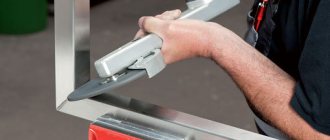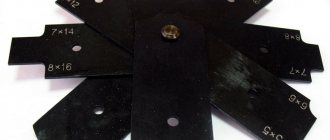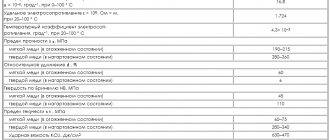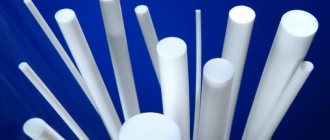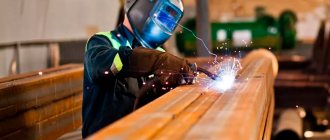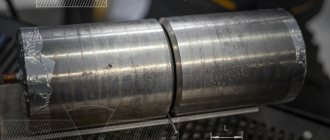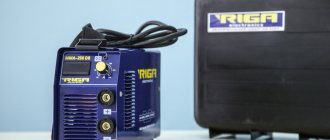Figure 1 - Main types of welded joints: a - butt;
b - tee; c - angular; d - lap welds Welds are divided according to the cross-sectional shape into butt (Figure 2.a) and corner (Figure 2.b). A variation of these types are cork seams (Figure 2.c) and slotted seams (Figure 2.d), made in overlap joints. Based on their shape in the longitudinal direction, continuous and intermittent seams are distinguished.
With the help of butt welds, mainly butt joints are formed (Figure 1.a), with the help of fillet welds - T-, cross, corner and lap joints (Figure 1.b - 1.e), with the help of plug and slotted seams lap joints can be formed and sometimes T-joints.
Butt welds are usually made continuous; A distinctive feature for them is usually the shape of the cutting of the edges of the parts being connected in cross section. Based on this feature, the following main types of butt welds are distinguished: with flanged edges (Figure 3.a); without cutting edges - one-sided and two-sided (Figure 3.b); with cutting of one edge - one-sided, two-sided; with a straight or curved cutting shape (Figure 3.c); with one-sided cutting of two edges; with a V-shaped groove (Figure 3.d); with two-sided cutting of two edges; X-shaped cutting (Figure 3.d). The groove can be formed by straight lines (beveled edges) or have a curved shape (U-shaped groove, Figure 3.e).
Figure 2 - Main types of welds: a - butt; b - angular; c - cork; g - slotted
The butt connection is most common in welded structures, as it has a number of advantages over other types of connections. It is used in a wide range of thicknesses of welded parts from tenths of a millimeter to hundreds of millimeters in almost all welding methods. With a butt joint, less filler material is consumed to form a seam, and quality control is easy and convenient.
Fillet welds are distinguished by the shape of the preparation of the welded edges in cross section and the continuity of the seam along the length.
According to the cross-sectional shape, fillet welds can be without edge grooves (Figure 4.a), with one-sided edge grooves (Figure 4.b), with double-sided edge grooves (Figure 4.c). In terms of length, fillet welds can be continuous (Figure 5.a) or intermittent (Figure 5.b), with a staggered (Figure 5.c) and chain (Figure 5.d) arrangement of seam sections. T-joints, lap joints and corner joints can be made with short sections of seams - spot welds (Figure 5.e).
Figure 4 - Preparation of the edges of fillet welds of T-joints: a - with flanging of the edges; b - without cutting edges; c, d, e, f - with edge grooves
Figure 4 - Preparation of the edges of fillet welds of T-joints: a - without cutting the edges; b, c - with edge cutting
Plug seams in their plan form (top view) usually have a round shape and are obtained as a result of complete melting of the top and partial penetration of the bottom sheets (Figure 6.a) - they are often called electric rivets - or by melting the top sheet through what was previously done in the top sheet hole (Figure 6.b).
Figure 5 - Fillet welds of T-joints
Figure 6 — Cross-sectional shape of plug and slotted seams
Slotted seams, usually of an elongated shape, are obtained by welding the top (covering) sheet to the bottom with a fillet weld around the perimeter of the slot (Figure 6. c). In some cases, the slot may be filled completely.
The shape of the edges and their assembly for welding are characterized by four main structural elements (Figure 7): gap b, blunting c, bevel angle b and cutting angle a, equal to b or 2b.
Existing methods of arc welding without cutting edges make it possible to weld metal of limited thickness (for one-sided manual welding - up to 4 mm, mechanized submerged arc welding - up to 18 mm). Therefore, when welding thick metal, it is necessary to cut the edges. The bevel angle of the edge provides a certain value for the cutting angle of the edges, which is necessary for the arc to penetrate deep into the joint and completely penetrate the edges to their entire thickness.
Figure 7 — Structural elements of edge preparation and assembly for welding
The standard cutting angle of the edges, depending on the welding method and type of connection, varies from (60±5) to (20±5) degrees. The type of groove and the angle of the edges determine the amount of additional metal required to fill the groove, and therefore the welding performance. For example, X-shaped cutting of edges compared to V-shaped allows reducing the volume of deposited metal by 1.6 - 1.7 times. The time required for edge processing is reduced. However, in this case it becomes necessary to weld on one side of the seam in an awkward ceiling position or to turn over the products being welded.
Bluntness c is usually (2 ± 1) mm. Its purpose is to ensure proper formation and prevent burns at the top of the seam. The gap b is usually equal to 1.5 - 2 mm, since at the accepted cutting angles the presence of a gap is necessary for penetration of the top of the seam, but in some cases, with a particular technology, the gap can be equal to zero or reach 8 - 10 mm or more.
For all types of seams, complete penetration of the edges of the elements being connected and the external shape of the seam, both on the front side (strengthening the seam) and on the back side, i.e. the shape of the reverse bead, are important. In butt welds and especially one-sided welds, it is difficult to weld the blunting edges to their entire thickness without special techniques to prevent burn-through and ensure good formation of the return bead.
Welds are classified according to a number of characteristics. Based on their appearance, seams are divided into convex, normal, and concave (Figure 8). As a rule, all seams are made with slight reinforcement (convex). If joints without reinforcement are required, this should be indicated on the drawing. Fillet welds are made weakened (concave), which is also noted in the drawing. Such seams are required to improve the performance of welded joints, for example under variable loads. Butt seams are not weakened; concavity in this case is a defect. An increase in the size of the welds compared to the specified ones leads to an increase in the weight of the welded structure and excessive consumption of electrodes. As a result, the cost of welded structures increases and the labor intensity of welding work increases.
Figure 8 - Classification of seams by appearance: a - convex; b - normal; c - concave
The formation of a smooth transition of the metal of the front and back rollers to the base metal is also of great importance, as this ensures high strength of the connection under dynamic loads. In fillet welds, it can also be difficult to weld the root of the seam to its full thickness, especially when welding with an inclined electrode. For these seams, a concave cross-sectional shape of the seam with a smooth transition to the base metal is recommended, which reduces the stress concentration at the transition site and increases the strength of the connection under dynamic loads.
Based on the number of layers and passes, single-layer, multi-layer, single-pass, and multi-pass seams are distinguished (Figures 9, 10).
Figure 9 - Classification of seams according to execution: a - one-sided; b - bilateral
Figure 10 - Classification of seams by the number of layers and passes: I - IV - number of layers; 1 - 8 - number of passes
Weld layer - part of the weld metal, which consists of one or more beads located at the same level of the cross-section of the weld. Bead - weld metal deposited or remelted in one pass.
When welding, each layer of a multilayer seam is annealed when the next layer is applied. As a result of this thermal effect on the weld metal, its structure and mechanical properties are improved. The thickness of each layer in multilayer seams is approximately 5 - 6 mm.
According to the effective force, seams are divided into longitudinal (flank), transverse (frontal), combined, and oblique (Figure 11). The front seam is located perpendicular to the force P, the flank seam is parallel, and the oblique seam is at an angle.
Figure 11 - Classification of seams according to the effective force: a - longitudinal (flank); b - transverse (frontal); c - combined; g - oblique
Based on their position in space, there are lower, horizontal, vertical and ceiling seams (Figure 12). They differ from each other in the angles at which the surface of the welded part is located relative to the horizontal. The ceiling seam is the most difficult to perform; the seam is best formed in the lower position. Ceiling, vertical and horizontal seams usually have to be made during manufacturing and especially during installation of large-sized structures.
Examples of designating welds by their position in space are given in Figure 13.
Figure 12 — Classification of welds according to their position in space
Figure 13 - Designation of welds according to their position in space: H - lower; P - ceiling; Pp - semi-ceiling; G - horizontal; Pv - semi-vertical; B - vertical; L - in a boat; PG - semi-horizontal
Electrode tilt
Welding seams are classified according to several criteria. The types and types of welding joints must be considered sequentially, delving into the intricacies of the process. The seam is affected by the location, direction and trajectory of the electrode.
After fixing the selected electrode in the clamp, setting the current, connecting the polarity, the welding process begins.
Each master has his own preferred angle of the electrode. Many consider the optimal value to be 70° from the horizontal surface.
An angle of 20° is formed from the vertical axis. Some work at a maximum angle of 60°. In general, most training guidelines include a range of 30° to 60° from the vertical axis.
In certain situations, when welding in hard-to-reach places, it is necessary to orient the electrode strictly perpendicular to the surface of the material being welded.
You can also move the electrode in different ways, in opposite directions: away from you or towards you.
If the material requires deep heating, then the electrode is directed towards itself. Following him in the direction of the welder is the working area. The resulting slag covers the fusion site.
If the work does not involve strong heating, then the electrode is moved away from you. The welding zone “crawls” behind it. The depth of heating with this type of weld is minimal. The direction is clear.
Electric arc
An electric arc is the space that exists between the surface and the electrode at the moment of maximum heating. It should be enough to cause an electrical discharge. The first thing welders learn to do in practice is control it. There are 3 arc gaps during welding:
- Short (0.1-0.15 cm). The main difference between this arc is that the metal does not heat up well across its width. A small depression is formed at the edges of the seam, which indicates poor quality.
- Long (0.35 – 0.6 cm). The arc periodically goes out, which also indicates insufficient heating. The result is also a marriage.
- Normal (0.2-0.3 cm). An option suitable for a welder who is just learning to work with the machine.
It is important to remember that its tension depends on the length of the arc, and also with its help the correct or incorrect structure of the seam is established.
Normal arc Source atl-met.ru
Trajectory of movement
The trajectory of the electrode has a particular influence on the seam. In any case, it has an oscillatory character. Otherwise, it will not be possible to sew the two surfaces together.
Oscillations can be similar to zigzags with different steps between the sharp corners of the trajectory. They can be smooth, resembling movement in an offset figure eight. The path can be similar to a herringbone or a capital letter Z with monograms at the top and bottom.
An ideal seam has a constant height, width, uniform appearance without defects in the form of craters, undercuts, pores, or lack of penetration. The name of the possible flaws speaks for itself. Having mastered your skills well, you can successfully apply any seam and weld a variety of metal parts.
Results of violation of welding technology
If the welding technology is violated at the joint, the following may occur:
- Burns (undercuts) are zones of critical heating of the metal, in which various chemical reactions (crystalline corrosion, etc.) began under the influence of high temperatures;
- Lack of penetration - zones in which the temperature was insufficient for mutual penetration of the edges into each other and the formation of a single monolithic structure;
- Non-fusion - the edges being joined have not heated to the melting temperature and have not fused to each other;
- Slag clogging - points of concentration of slag substances that have penetrated in a liquid state from low-quality electrodes into the weld pool and, upon solidification, formed foreign crystalline inclusions;
- Pores appear due to spattering metal due to sudden peak temperatures in the weld pool;
- Cracks appear due to poor-quality joining of two types of steel that have different melting points;
- Microcavities arise due to uneven heating and cooling of the metal.
Standards and the concept of leg
The weld begins to form in the working area when the metals are molten, and is finally formed after solidification.
The existing classification groups seams according to various criteria: the type of connection of parts, the resulting shape of the seam, its length, the number of layers, orientation in space.
The types of possible welded joints are shown in the standard for manual and arc welding GOST 5264. Connections made by arc welding in a shielding gas atmosphere are standardized by the GOST 14771 document.
GOSTs have a designation for each welded joint, as well as a table containing the main characteristics, in particular the values of the leg of the weld.
It’s quite easy to understand what a leg is by looking at the drawing of the parts being connected. This is the side of a speculative isosceles triangle of maximum dimensions that will fit in the cross section of the seam. A correctly calculated leg value guarantees the strength of the connection.
For parts of uneven thickness, the cross-sectional area of the part in its thinnest part is taken as a basis. You should not try to unduly increase the leg. This can lead to deformation of the welded structure. In addition, the consumption of materials will increase.
Checking leg dimensions is carried out using universal reference templates presented in specialized literature.
Ceiling seam
Now you can figure out how to weld a ceiling seam using electric welding. It is necessary at a small distance from the surface using a refractory electrode. Because of this, a cap appears at the end that can prevent the material from spreading. As the seam is created, the end of the electrode is evenly removed, and then approaches the arc. As it moves away, it goes out and the metal hardens. To know how to weld a ceiling seam, you should familiarize yourself with the information about what electrodes are used for it. Regardless of the direction of the seam, it should be of small diameter.
When working with ceiling welding, gas bubbles float up at the root of the seam. This could lead to marriage. It is recommended to use it only when it is impossible to complete the bottom seam.
Ceiling connection Source i.ytimg.com
Types of connections
Depending on the relative position of the parts, welding joints occur:
- end-to-end;
- overlap;
- in an angular way;
- in a tee way.
When butt welding, the ends of two parts located in the same plane are welded. The joint can be made with a flange, without a bevel, or with a bevel. The shape of the bevel may resemble the letters X, K, V.
In some cases, welding is done with an overlap, then one part is partially mounted on another, located parallel. The combined part is an overlap. Welding is done without bevel on both sides.
Often there is a need to make a welded corner. This connection is referred to as the corner type. It is always done on both sides and may not have bevels or have a bevel on one edge.
If the welded parts result in the letter T, then a T-joint has been made. Sometimes parts welded with a T-seam form an acute angle.
In any case, one part is welded to the side of the other. Welding is carried out on both sides without a bevel or with bevels on each side.
Preparation for welding
In order for the seam to be of high quality, proper preparation of the sides for welding is required. If the metal is thicker than 5 mm, one-sided edge cutting is performed with an angle of 45º. With a plate thickness of 10 mm, cutting is required on both sides. Without such preparation, it will not be possible to melt the metal deeply and the connection will be superficial. Based on this, the types of chamfers are:
- V-shaped;
- Y-shaped;
- X-shaped;
- U-shaped.
Rusty metal leads to unstable arc combustion and “spitting” of slag. The sides in the welding zone (at least 20 mm from the connection line) must be cleaned of rust, traces of paint, and oil. If you have to weld thin metal 1-1.5 mm end-to-end, use a copper substrate to prevent burns.
To prevent the workpiece from moving during welding, tacks are first made, and they must be on both sides. This applies to all types of connections.
Shape and extent
The shape of the seam can be convex, even (flat). Sometimes it becomes necessary to make a concave shape. Convex joints are designed for increased load.
The concave areas of the alloys withstand dynamic loads well. Flat seams, which are made most often, are characterized by versatility.
The length of the seams is continuous, without intervals between the fused joints. Sometimes interrupted stitches are sufficient.
An interesting industrial variation of the intermittent seam is the joint formed by resistance seam welding. It is done on special equipment equipped with rotating disk electrodes.
They are often called rollers, and this type of welding is called roller welding. Continuous connections can also be made using such equipment. The resulting seam is very strong and absolutely airtight. The method is used on an industrial scale for the manufacture of pipes, containers, and sealed modules.
Briefly about the main thing
There are 4 main ways to create seams: ceiling, horizontal, vertical, and bottom.
The last one is the simplest, and the first one is more difficult and is used only if all the others cannot be completed.
There are also several types of trajectories, the most popular are triangle and Christmas tree.
It is necessary to monitor the length of the arc so that it does not exceed 2-3 mm, otherwise a defect will result.
The slag must be cleaned after welding. This can be done in three processing methods: thermal, mechanical and chemical. A combination of the last two works best.
Ratings 0
Layers and spatial arrangement
A metal seam can consist of a bead made in one pass. In this case it is called single-layer. If the parts being welded are thick, several passes are performed, as a result of which beads are sequentially formed one on top of the other. This welding joint is called multilayer.
Considering the variety of production situations in which welding occurs, it is clear that the seams are oriented differently in each specific case. There are lower, upper (ceiling) seams, vertical and horizontal.
Vertical seams are usually welded from bottom to top. The trajectory of moving the electrode along a crescent, herringbone or zigzag is used. It is more convenient for novice welders to move the crescent.
When welding horizontally, several passes are made from the lower edge of the parts being joined to the upper edge.
In the lower position, butt welding is carried out or by any angular method. A good result is obtained by welding at an angle of 45 °, “in a boat”, which can be symmetrical or asymmetrical. When welding in hard-to-reach places, it is better to use an asymmetrical “boat”.
The most difficult thing to do is weld in the ceiling position. This requires experience. The problem is that the melt tries to drain out of the work area. To prevent this from happening, welding is carried out with a short arc, the current strength is reduced by 15-20% compared to normal values.
If the thickness of the metal at the welding site exceeds 8 mm, then several passes must be performed. The diameter of the first pass should be 4 mm, subsequent ones - 5 mm.
Depending on the orientation of the seam, select the appropriate position of the electrode . To make horizontal, vertical, ceiling connections, and weld non-rotating pipe joints, the electrode is directed at an angle forward.
When welding corner and butt joints, the electrode is directed at an angle backwards. Hard-to-reach places are welded with an electrode at a right angle.
Cleaning seams
After completing all work, it is necessary to clean the weld from slag, otherwise there is a chance of corrosion. There are 3 main ways:
- Heat treatment . Removes residual stress from the material that forms during welding. There are two types: local (the seam itself is heated or cooled) and general (the entire seam is processed).
- Mechanical restoration. Removes residual slag from the part. The cleaned seam must then be checked for strength by tapping it with a hammer or pliers.
- Chemical processing . A special anti-corrosion material is applied.
Thermal stripping Source gidpokraske.ru
You can use many tools for stripping, the main thing is to choose them correctly. You can use a metal brush, a special grinder or an angle grinder with an abrasive wheel.
For mechanical processing, the easiest method is manual, since its use only requires a metal brush. But the presence of the special machines indicated above will speed up the process. With this cleaning you can remove burrs, oxides, scale and traces of tarnish. It is also important to remember that for high-quality processing it is necessary to choose the right grinding disc.
Chemical cleaning is considered effective if combined with mechanical cleaning. Can be processed by etching or passivation. For the first option, a special composition is used that forms a homogeneous layer, which after a certain time can be removed mechanically. Corrosion does not form on the material after this.
Corrosion on the connection Source otoplenie-gid.ru
Weld joint processing
When welding, slag is formed. If slag inclusions get into the weld, its quality deteriorates. All slag deposits must be cleaned off.
If welding is performed in several passes, then the seams are cleaned after each welding stage. In this case, any methods are used. First, the welded parts are hammered and cleaned with a stiff brush.
Then a rough cleaning is carried out. Small parts are cleaned with special knives or grinding wheels. Large blanks are cleaned on machines. At the final stage, the welded joint is polished.
Often a fiber wheel of a grinding machine is used for this. There are other ways to polish welded joints.
Welding is constantly evolving. New materials are appearing and technology is improving. It is necessary to follow the news in welding to learn a lot of new and interesting things.
Vertical welding using an inverter
After analyzing how to properly weld a vertical seam using electric welding, you can learn how to weld a vertical seam using an inverter. The second method is manual, but it works on a slightly different principle, using a welding wire electrode (consumable). With this method of work, you should carefully monitor how the end of the device is guided. If you choose the wrong position of the holders or the angle of inclination, you will end up with a defect.
The parts should be connected in separate sections (points), constantly removing the electrode and putting it back so that the material splashes over the surface. This way the seam comes out better than with a conventional machine, since the arc will be in continuous contact with the surface while the point is being formed.
Inverter Source i1.rozetka.ua
